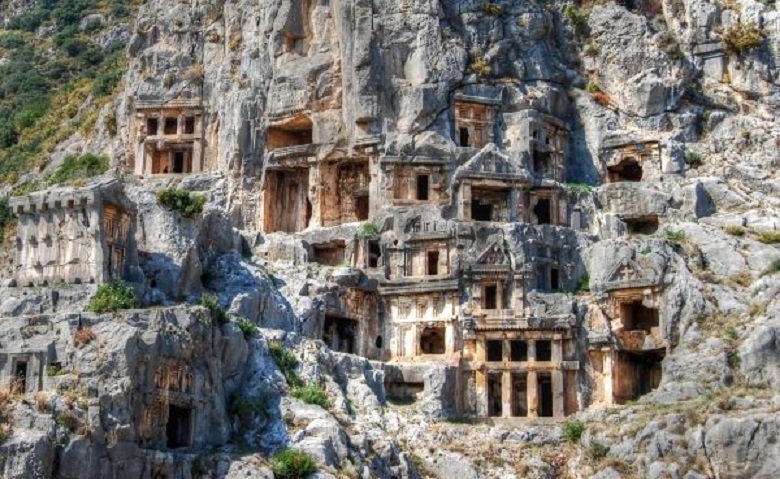Even at the dawn of humankind, ancient people used caves as shelters from lousy weather and predatory animals. Even though stone is a very durable material, our ancestors, having only a primitive tool, created unique temples, fortresses and entire cities.
Even though progress has reached unprecedented heights, and the need for such architecture has long disappeared, the preserved structures of the Ancient World do not cease to arouse keen interest.
1. Lycian rock tombs of Myra (Turkey)

The Lycian rock tombs of Myra are one of the most exciting tombs of their kind in Anatolia. Tombstones of architecture appeared high in the mountains in the 6th century. BC. This strange arrangement explains that the Lycians believed that it would be more convenient for the angels to transfer the dead to the afterlife. Despite the outward splendour, the interiors of the tombs are chambers carved into the rock with a simple monolith inside, just enough to contain the body of the deceased. But the vast halls and galleries were left empty as a result of robberies.
2. The oldest city of Petra, carved into the rock (Jordan)
In the south of Jordan, Petra is one of the most famous places in the region and a national treasure. This ancient city is notable because it was carved on the slopes of Jebel al-Madhba by the Arab people – the Nabateans, who settled in the south of Jordan more than 2000 years ago. The ingenious architects and stonecutters were able to place a full-fledged city in the thickness of the rock, which still preserves fine examples of ancient art, from dwellings, temples, tombs, treasuries and a theatre, to an ingenious complex of dams and water channels. Since 1985, Petra has been a UNESCO World Heritage Site and one of the world’s new Seven Wonders.
3. Kropfenstein Castle (Switzerland)
Not much know about the mysterious Kropfenstein Castle, carved high in the Alps. Studying its architecture, researchers concluded that it roughly erected in the XIII century. Over time, the need for impregnable fortresses had already disappeared, and by the end of the 15th century. The castle was abandoned by people, which led to its gradual decline. Thanks to the protection of the rocky ledge, most of the castle’s fortifications have survived, but they are in a deplorable state.
4. Medieval sacred site Lalibela (Ethiopia)
Eleven cave churches of Lalibela, erected in the heart of Ethiopia in the XII-XIII centuries, are considered one of the main shrines of the country. They located at an altitude of more than 2.5 thousand meters above sea level in the mountainous surroundings. Their construction attribute to King Lalibela, who intended to build a “New Jerusalem” in the 12th century after Muslim conquerors stopped the pilgrimage of Christians to the Holy Land.
For this reason, in the main church, you can see a replica of Calvary, copies of the tomb of Christ, Adam and the cradle of Christmas. Today, Lalibela attracts many tourists and Christian pilgrims who flock to sacred places of worship.
5. Cliff Palace cave complex in Mesa Verde National Park (USA)
One of America’s most extensive cave housing complexes, Cliff Palace, is located in Mesa Verde National Park, Colorado. A large complex began to create in the XII century. And expanded over the next several centuries. Recent research has shown that 150 rooms carve into the sandstone of the Cliff Palace during this time, and almost 600 rock dwellings concentrated within the park.
6. Oldest Caves of Ajanta (India)
The first Buddhist cave monuments in Ajanta (Ajanta Caves) date back to the 2nd-1st centuries. BCE During the reign of Gupta (5th-6th centuries AD), many ornate temple caves added to the original group, which arouse increased interest among researchers and tourists. The paintings and sculptures carved in stone are considered masterpieces of Buddhist religious art that have had a significant artistic influence over many generations. In 1983 UNESCO declared the Ajanta Caves a World Heritage Site.
7. Longmen Grottoes (China)
In the Chinese province of Henan Longmen, in the cliffs of the Xiangshan and Longmenshan mountains, the largest and most impressive collection of national art of the late Northern Wei and Tang dynasties (316-907) create over the centuries. The Longmen Caves includes more than 2,300 caves and niches carved by hand in steep rocks about 1 km long. Almost 110 thousand Buddhist stone statues, more than 60 stupas and 2.8 thousand inscriptions carved on the walls of grottoes and caves still keep in these human-made shelters.
8. Mountain castle Predjama (Slovenia)
Predjama Castle is an imposing structure full of mystery and history. The impregnable medieval fortification locates in the middle of a 123-meter cliff and, for more than 800 years, has attracted thrill-seekers with a network of secret tunnels. According to rumours, it was from there that the knight Erazem set off on his predatory expeditions. Also, the mysterious castle served as a refuge for the disgraced knight in the 15th century. It is so special and unique that it is one of the ten most charming castles globally and so romantic that many couples choose it for their wedding ceremony. It also lists in the Guinness Book of Records as “The world’s largest cave castle.”
